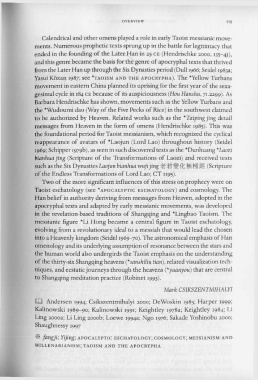Page 155 - The Encyclopedia of Taoism v1_A-L
P. 155
OVERVI EW lIS
Calendrical and other omens played a role in early Taoist messianic move-
ments. umerous prophetic texts sprung up in the battle for legitimacy that
ended in the founding of the Later Han in 25 CE (Hendrischke 2000, 135- 43),
and this genre became the basis for the genre of apocryphal texts that thrived
from the Later Han up through the Six Dynasties period (Dull 1966; Seidel 1983a;
Yasui K6zan 1987; see *TAOISM AND THE APOCRYPHA). The *Yellow Turbans
movement in eastern China planned its uprising for the first year of the sexa-
gesimal cycle in 184 CE because of its auspiciousness (Hou Hanshu, 71.2299). As
Barbara Hendrischke has shown, movements such as the Yellow Turbans and
the *Wudoumi dao (Way of the Five Pecks of Rice) in the southwest claimed
to be authorized by Heaven. Related works such as the *Taipingjing detail
messages from Heaven in the form of omens (Hendrischke 1985). This was
the foundational period for Taoist messianism, which recognized the cyclical
reappearance of avatars of *Laojun (Lord Lao) throughout history (Seidel
1969; Schipper 1979b), as seen in such discovered texts as the *Dunhuang *Laozi
bianhua jing (Scripture of the Transformations of Laozi) and received texts
such as the Six Dynasties Laojun bianhua wuji jing ;{!; tt ~1t $.!€~ ~~ (Scripture
of the Endless Transformations of Lord Lao; CT II95).
Two of the more significant influences of this stress on prophecy were on
Taoist eschatology (see * APOCALYPTIC ESCHATOLOGY) and cosmology. The
Han belief in authority deriving from messages from Heaven, adopted in the
apocryphal texts and adapted by early messianic movements, was developed
in the revelation-based traditions of Shangqing and *Lingbao Taoism. The
messianic figure *Li Hong became a central figure in Taoist eschatology,
evolving from a revolutionary ideal to a messiah that would lead the chosen
into a Heavenly kingdom (Seidel 1969-70). The astronomical emphasis of Han
omenology and its underlying assumption of resonance between the stars and
the human world also undergirds the Taoist emphasis on the understanding
of the thirty-six Shangqing heavens (*sanshiliu tian), related visualization tech-
niques, and ecstatic journeys through the heavens (*yuanyou) that are central
to Shangqing meditation practice (Robinet 1993).
Mark CSIKSZENTMIHALYI
III Andersen 1994; Csikszentmihalyi 2000; DeWoskin 1983; Harper 1999;
Kalinowski 1989- 90; Kalinowski 1991; Keightley 1978a; Keightley 1984; Li
Ling 2000a; Li Ling 2000b; Loewe 1994a; Ngo 1976; Sakade Yoshinobu 2000;
Shaughnessy 1997
* fangji; Yijing; APOCALYPTIC ESCHATOLOGY; COSMOLOGY; MESSIANISM AND
MILLENARIANISM; TAOISM AND THE APOCRYPHA

